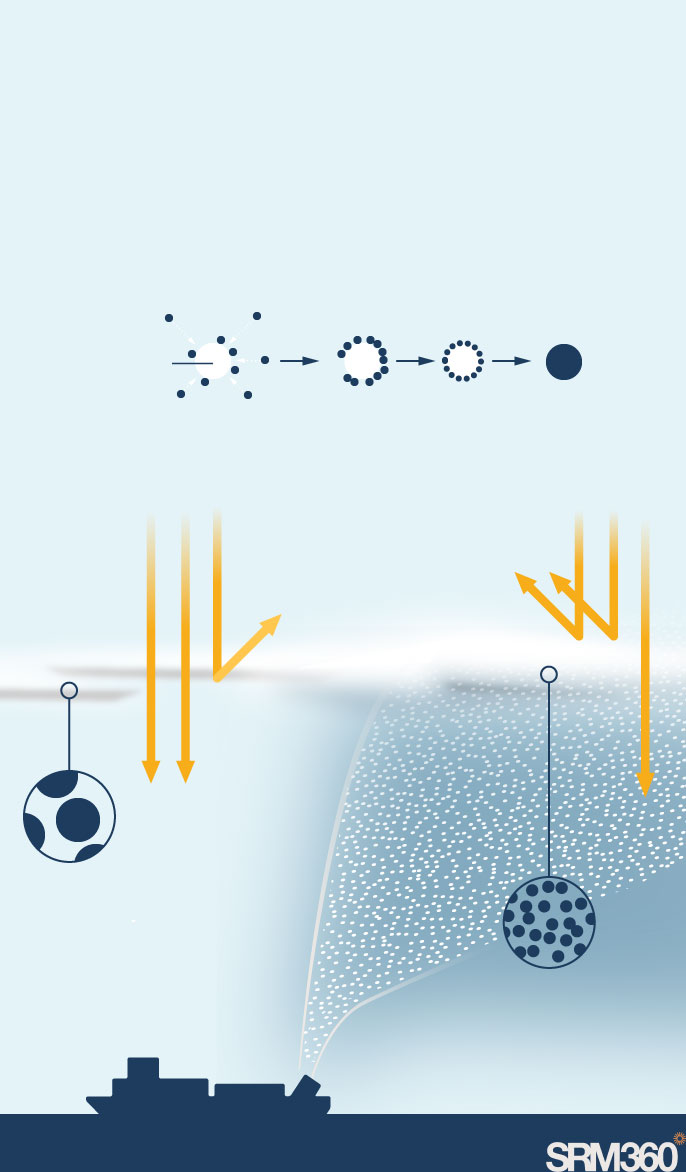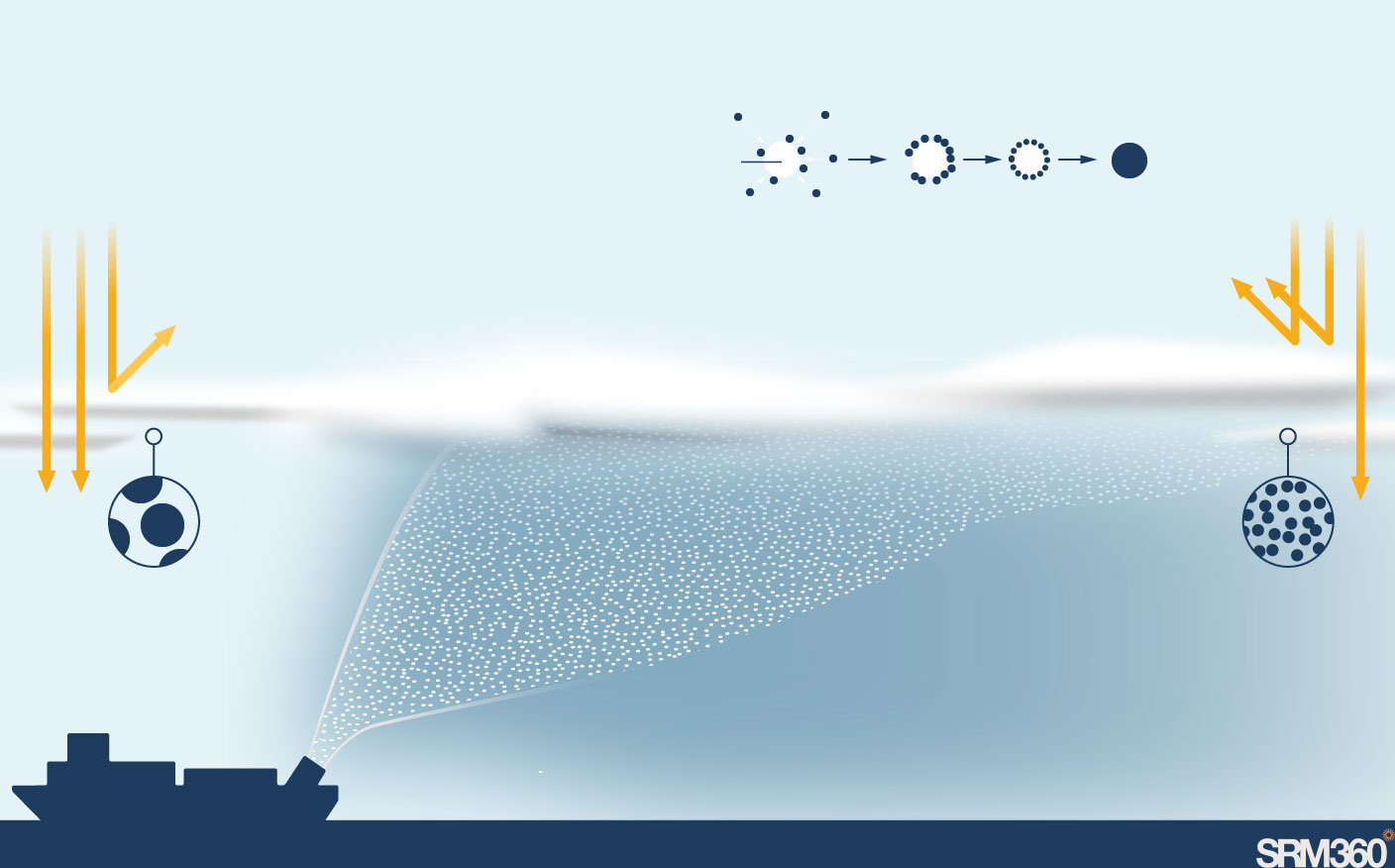Article
Marine Cloud Brightening
Marine cloud brightening (MCB) is an idea to enhance the reflectivity of low-lying clouds over the oceans. Spraying tiny sea-salt particles below the cloud base could cause the clouds to form with more, smaller droplets which would make them more reflective. Could this offer an effective means of countering regional or global climate change?
Key takeaways
- MCB might be able to produce a strong local, regional, or even global cooling effect by making low-lying clouds over the oceans more reflective.
- MCB’s cooling effects would be uneven, which could lead to large shifts in rainfall patterns.
- While most studies of MCB are based on computer simulations and observations of natural analogues, ongoing field experiments could provide crucial insights.
MCB is an idea to reflect more sunlight over the oceans by increasing the number of droplets in low-lying marine clouds.1 Models suggest large-scale MCB deployment could decrease temperatures on regional to global scales,1 while smaller-scale efforts might provide local benefits such as short-term relief for heat-stressed ecosystems like the Great Barrier Reef.2
Marine cloud brightening
Marine cloud brightening (MCB) is an idea to enhance the reflectivity of low-lying clouds over the oceans. MCB may be able to produce a large regional cooling effect, but the uneven cooling may lead to large shifts in global rainfall patterns.

Ships would spray tiny sea salt particles into the clouds. These particles are so small they stay suspended in the air and act as seeds for forming new, smaller cloud droplets.
Water molecules condense around the particle to form a cloud droplet
Sea-salt particle
Droplet
Water molecule
Clouds with fewer, larger cloud droplets reflect less light
More, smaller droplets reflect more light.

Ships would spray tiny sea salt particles into the clouds. These particles are so small they stay suspended in the air and act as seeds for forming new, smaller cloud droplets.
Water molecules condense around the particle to form a cloud droplet
Sea-salt particle
Droplet
Water molecule
Clouds with fewer, larger cloud droplets reflect less light
More, smaller droplets reflect more light.

Ships would spray tiny sea salt particles into the clouds. These particles are so small they stay suspended in the air and act as seeds for forming new, smaller cloud droplets.
Water molecules condense around the particle to form a cloud droplet
Sea-salt particle
Droplet
Water molecule
More, smaller droplets reflect more light.
Clouds with fewer, larger cloud droplets reflect less light
Brightening clouds with microscopic sea-salt particles
Cloud droplets form when the air gets cool and humid enough. All droplets form around a microscopic particle. These tiny particles are aerosols, which are so small they stay suspended in the air, and some act as a “seed”, allowing for the growth of cloud droplets.3 By spraying sea-salt particles below clouds, MCB would add many more of these “seed” particles, encouraging clouds to form more, smaller droplets,4 which brightens clouds.5 A similar effect is seen in ship tracks, where clouds are brightened along the path of ships due to pollution.5
Research suggests that MCB would be most effective in regions where marine stratocumulus clouds form5 – commonly off the western edge of continents in the subtropics. They cover about 20% of low-latitude oceans and produce a large cooling effect,6 which MCB has the potential to strengthen.5
Is MCB feasible?
To brighten marine clouds, masses of these tiny sea-salt particles would need to be generated in targeted areas over the ocean. Ship-based devices to spray seawater at high pressures have typically been considered for this, though there are suggestions for approaches using aircraft.7
The challenge would be to produce a large enough number of particles of the right size, across a wide enough area.8 Scientists have estimated that sea-salt aerosols around 50 nanometres across – about one thousandth the width of a human hair – would work best.8
Producing vast numbers of such tiny sea-salt particles will be challenging. Seawater is highly corrosive, and it can leave salt deposits that clog up fine nozzles. Teams around the world9 are working to solve this problem and are developing and testing devices that they hope will be able to produce sufficient numbers of these fine particles.
One recent study found that counteracting the warming from a doubling of carbon dioxide concentrations (about 3°C of warming) would require at least 10,000 ocean-going sea-salt sprayers deployed over half of the world’s oceans.10 Whether by ship-based sprayers or aircraft, cost estimates for deploying MCB at this scale are on the order of tens of billions of dollars per year.7
Potential impacts
MCB is an inherently local intervention as each sprayer ship would only affect a relatively small patch of clouds. By adding more ships, larger regions could be cooled, and, at a sufficiently large scale, it could lower global temperatures.1
Beyond the local cooling effects, the climate consequences of MCB would depend strongly on where and how it is deployed. Due to the patchy nature of the cooling, which would be concentrated over the ocean and in regions with susceptible clouds even if it were deployed globally, MCB would produce substantial shifts in rainfall patterns.11
While many climate model simulations suggest MCB may offer the potential to produce a substantial cooling effect, major uncertainties remain. One recent modelling study found that in a warmer world MCB could be less effective, and potentially even counterproductive in some regions.12 Aerosol–cloud interactions are complex and one of the largest uncertainties in all of climate science,4 which means climate model results for MCB should be treated with caution.
Field experiments of MCB
Given these fundamental uncertainties, researchers broadly agree that field experiments involving the targeted release of particles will be essential to understanding MCB’s potential.8 Several groups are developing sea-salt sprayers for MCB, and two field-based MCB studies have been initiated in recent years.
Starting in March 2020, Australian scientists conducted the first of a series of outdoor MCB experiments. The Australian MCB experiment is part of the Reef Restoration and Adaptation Program (RRAP), an effort to save the Great Barrier Reef, which is increasingly threatened by bleaching as ocean temperatures rise.
The project aims to seed marine clouds using a sea-salt spray to shade the coral and lower ocean surface temperatures. A series of field experiments have tested a sea-salt sprayer device designed to produce the tiny sea-salt particles needed for MCB.
A similar outdoor MCB experiment started in April 2024 off the coast of Alameda, California, using the Cloud-Aerosol Research Instrument (CARI). A team from the University of Washington began an outdoor experiment of their sea-salt sprayers on the deck of the USS Hornet, a World War II-era aircraft carrier that is now a museum.
However, officials in Alameda halted the experiments in May 2024. According to the City of Alameda’s announcement, the experiment violated the terms of the USS Hornet’s lease.
At the June 4 2024 Alameda City Council meeting, analysts working on behalf of the City testified that the aerosol spray was similar to natural sea spray and posed no health risks. Despite this, the City Council voted unanimously to discontinue the experiment citing concerns for human health and the environment.
MCB may be an effective way to cool the climate, but substantial uncertainties remain
MCB may have the potential to greatly reduce the temperature in some ocean regions and could potentially be scaled up to have a significant global cooling effect.1 However, substantial uncertainties around its potential effectiveness remain.8
While field experiments for MCB can be controversial, they would offer a unique means of reducing these scientific uncertainties and would be essential to determining whether MCB is feasible.8
MCB could not cool the planet evenly; it would only work over the oceans and would be more effective in some places than others. This patchy cooling could be a problem if it were deployed at a large scale as it could lead to substantial changes in global rainfall patterns.11
Open questions
- Can an effective method to produce suitable sea-salt aerosol particles to brighten marine clouds be developed?
- How can the impacts of MCB field experiments on clouds be detected and distinguished from natural variability in cloud reflectivity?
- What impact would different strategies for MCB deployment have on rainfall patterns?
Ask us a question!
Endnotes
- Latham J, Bower K, Choularton T, et al. (2012). Marine cloud brightening. Philosophical Transactions of the Royal Society A: Mathematical, Physical and Engineering Sciences; 370: 4217–4262. https://doi.org/10.1098/rsta.2012.0086
- Latham J, Gadian A, Fournier J, et al. (2014). Marine cloud brightening: Regional applications. Philosophical Transactions of the Royal Society A: Mathematical, Physical and Engineering Sciences; 372. https://doi.org/10.1098/rsta.2014.0053
- Scientists call particles that provide surfaces for cloud droplet formation “cloud condensation nuclei” or CCNs.
- This effect of aerosols on clouds is known as the “Twomey Effect”.13
- Diamond MS, Director HM, Eastman R, et al. (2020). Substantial Cloud Brightening From Shipping in Subtropical Low Clouds. AGU Advances; 1. https://doi.org/10.1029/2019AV000111
- Schneider T, Kaul CM, Pressel KG. (2019). Possible climate transitions from breakup of stratocumulus decks under greenhouse warming. Nat Geosci; 12: 164–168. https://doi.org/10.1038/s41561-019-0310-1
- Claudel C, Lockley A, Hoffmann F, et al. (2024). Marine-cloud brightening: an airborne concept. Environ Res Commun; 6. https://doi.org/10.1088/2515-7620/ad2f71
- Feingold G, Ghate VP, Russell LM, et al. (2024). Physical science research needed to evaluate the viability and risks of marine cloud brightening. Science advances. 10(12):eadi8594. https://doi.org/10.1126/sciadv.adi8594
- For example, from the University of Washington and Southern Cross University.
- Wood R. (2021). Assessing the potential efficacy of marine cloud brightening for cooling Earth using a simple heuristic model. Atmos Chem Phys; 21: 14507–14533. https://doi.org/10.5194/acp-21-14507-2021
- Stjern CW, Muri H, Ahlm L, et al. (2018). Response to marine cloud brightening in a multi-model ensemble. Atmospheric Chemistry and Physics. 18(2):621-34. https://doi.org/10.5194/acp-18-621-2018
- Wan JS, Chen CCJ, Tilmes S, et al. (2024). Diminished efficacy of regional marine cloud brightening in a warmer world. Nature Climate Change. https://doi.org/10.1038/s41558-024-02046-7
- Twomey S. (1974). Pollution and the Planetary Albedo. Atmos Environ; 8: 1251–1256. https://doi.org/10.1016/0004-6981(74)90004-3
Citation
Reuse this work freely
The content produced by SRM360 is open access under the Creative Commons BY license. You are free to use, distribute, and reproduce these in any medium, provided that SRM360 and the authors are credited.
The sources used by SRM360 are subject to the licence terms of the original third party. We will always indicate the original sources in our content, so please review the licence of any third-party sources before use and redistribution.





